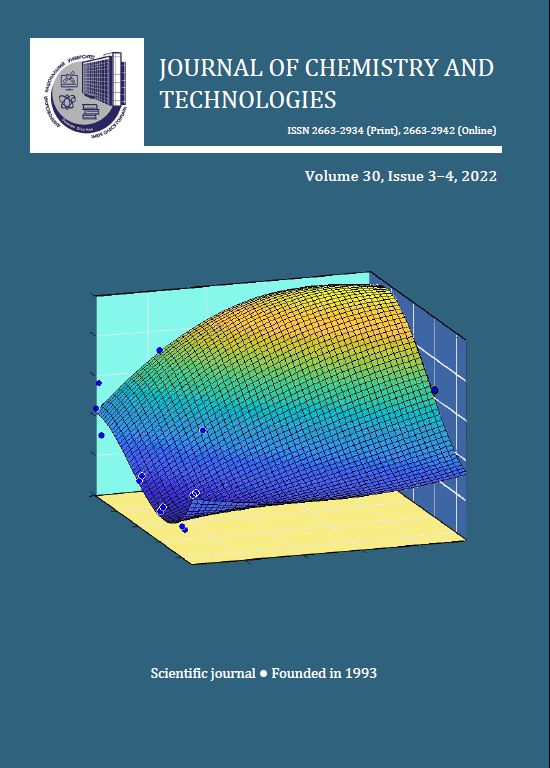INFLUENCE OF SURFACTANTS ON RHEOLOGICAL PROPERTIES OF OIL-WATER-COAL EMULSIONS
DOI:
https://doi.org/10.15421/jchemtech.v30i3.247272Keywords:
Keywords: oil-water-coal emulsions, rheological properties, coal, motor oils, viscosity.Abstract
The technology for obtaining highly concentrated oil-water-coal fuels used as liquid fuel in power generating plants associated with thermal engineering requirements: maximum filling of the emulsion dispersion medium with combustible components (for example, dispersed coal). In this case, the system must be stable for a long period and have a viscosity that will provide the possibility of easy transportation of fuel through pipes, storage and spraying by nozzles (with a viscosity of 1.5–2 Pa s). To study the effect of chemical reagents on the rheological properties of composite fuel, systems were obtained based on «LG» coal (Ad = 9.3 %) with a solid phase content St = 40%, used engine oil Comma Xtech 5W-30 (Cm = 49 %), water CH2O = 10 % and chemical additive 1 %. The effectiveness of reducing the viscosity of the system by a chemical additive decreases: RH-1 > DT-2 > ResinAnt 2 > DT-1 > WA-4 > ER-3 > WA-2 > WA-5 > OP-10. Additives such as ResinAnt 2, DT-2, RH-1 have the optimal ability to reduce the viscosity of the oil-water – coal fuels.
References
International Energy Outlook with projections to 2040. (2013). Washington: U.S. Energy Information Administration. https://www.eia.gov/outlooks/ieo/pdf/0484(2013).pdf
Lam, S.S., Liew, K., Cheng, C.K., Chase, H.A (2015). Catalytic microwave pyrolysis of waste engine oil using metallic pyrolysis char. Appl. Catal., B 176–177(1), 601–617.
https://doi.org/10.1016/j.apcatb.2015.04.014
Chayka, O. G. Kovalchuk, O. Z., Chayka, Y. A. (2009). Monitoring the formation of waste oils. Proceedings Scientifical Works, 221–224.
Kapustina, V., Havukainen, J., Virkki-Hatakka, T., Horttanainen M (2014.) System analysis of waste oil management in Finland. Waste Manage. Res. 32(4), 297–303.
https://doi.org/10.1177/0734242X14523663
Statistical Review of World Energy. London: BP. (2016). http://www.bp.com
Boughton, B. (2004). Environmental Assessment of Used Oil Management Methods Environ. Sci. Technol. 38(2), 353–358.
https://doi.org/10.1021/es034236p
Goncharuk, V.V., Makarov, A. S., Kosygina, I. M. Prospects for using composite liquid fuel in power engineering. (2020) The Problems of General Energy, 2(61), 38–42. doi: https://doi.org/10.15407/pge2020.02.038
Kurgankina, M. A., Nyashina, G. S., Strizhak, P. A. (2019). Prospects of Thermal Power Plants Switching from Traditional Fuels to Coal-Water Slurries Containing Petrochemicals. Sci. Total Environ., 671, 568–577. doi: 10.1016/j.scitotenv.2019.03.349
Glushkov, D. O., Strizhak, P. A., Chernetskiy, M. Yu. (2016). [Organovodougolnoe toplivo: problemy i dostizheniya (obzor).] Teploenergetika, 10, 31–41. (in Russian) doi: 10.1134/S0040363616100039
Zhang, K., Cao, Q., Jin, L., Li, P., Zhang, X. (2017). A Novel Route to Utilize Waste Engine Oil by Blending It With Water and Coal. J. Hazard. Mater. 332, 51–58. doi: 10.1016/j.jhazmat.2017.02.052
Gorlov, Ye. G. (2004). [Kompozitsionnye vodosoderzhashchie topliva iz ugley i nefteproduktov]. Khim. tverdogo topliva, (6), 50–61. (in Russian)
Pynchuk, V. A., Ghubynskyj, M. V., Potapov, B. B. (2008). [Yspoljzovanye vodougholjnogho toplyva y produktov egho pererabotky v эnerghetyke y metallurghyy]. Metalurghijna teplotekhnika: Zb. nauk. pr. Nacionaljnoji metalurghijnoji akademiji Ukrajiny. Dnepropetrovsk: Novaja ydeologhyja, 221–227. (in Ukraine)
Mokhov, V. F., Gorlov, Ye. G., Golovin, G. S. (1999). [Ugolno-uglevodorodnye kompozitsionnye topliva iz ugley Kuzbassa.] Khim. i prirodosberegayushchie tekhnologii ispolzovaniya uglya: Sbornik trudov mezhdunarodnoy konferentsii. M.:MGU, 69–71. (in Russian)
Tripathi, A.K., Ojha, D.K., Vinu, R. (2015.) Selective production of valuable hydrocarbons from waste motorbike engine oils via catalytic fast pyrolysis using zeolites. J. Anal. Appl. Pyrolysis. 114, 281–292. https://doi.org/10.1016/j.jaap.2015.06.009
Lapin, D. A., Lyrshchikov, S. Yu., Strizhak, P. A., Shevyrѐv, S. A. (2017). [Vliyanie fraktsionnogo sostava tverdykh komponentov vodougolnogo topliva na kharakteristiki zazhiganiya i goreniya] Khim. tverdogo topliva, 2, 23–29. (in Russian)
Makarov, A. S., Makarova, K. V. (2020) [Physico-chemical and technological bases for the formation of coagulation structures of technical dispersions]. Kyiv Scientific thought. (in Ukraine).
Gyulmaliev A.M., Golovin G.S., Gladun T.G. (2003). [Teoreticheskie osnovy khimii uglya]. M.: Izdatelstvo MGU. (in Russian)
Motornye masla Comma Xtech 5W-30. www.CommaOil.com
Urev, N. B. (1980). [Vysokokontsentrirovannye dispersnye sistemy]. M.: Khim.
Rebinder, P. A. (1979). [Izbrannye trudy. Poverkhnostnye yavleniya v dispersnykh sistemakh. Fiziko-khimicheskaya mekhanika], M.: Nauka. (in Russian).
Veselovskaya, Ye. V. (2017). [Issledovanie struktury i osobennostey adsorbtsionnykh vzaimodeystviy na poverkhnosti energeticheskikh ugley]. Izvestiya vysshikh uchebnykh zavedeniy. Severo-Kavkazskiy region. Seriya: Tekhnicheskie nauki, 2 (194), 40-45. (in Russian)
Kruchko, I. M., Makarov, A. S., Kosyghina, I. M.. (2020) [Vplyv ghranulometrychnogho skladu dyspersnoji fazy na reologhichni vlastyvosti maslo-vodo-vughiljnykh emuljsij na osnovi antracytu]. Vughlekhimichnyj zhur., (4), 4–7. (in Ukrainian). doi: 10.31081/1681-309X-2020-0-4-4-8.
A.V. Zenkov, D.V. Gvozdyakov, V.Ye. Gubin. (2020) [Vliyanie zhidkikh goryuchikh komponent na vyazkost vodougolnogo topliva]. Bulletin of the South Ural State University. Ser. Power Engineering. 20(3), 26–32. doi: 10.14529/power200303
Khodakov G.S. (2003). [Reologiya suspenziy. Teoriya fazovogo techeniya i ee eksperimentalnoe obosnovanie]. Rossiyskiy khim. Zhur,. 47(2),33–44. (in Russian).
Savitskiy, D. P. (2016) [Vliyanie vodno glitserinovykh smesey na reologicheskie svoystva suspenziy uglya]. Kolloidnyy zhur., 78(1), 95–100. DOI: https://doi.org/10.7868/S002329121601016X (in Russian).
Makarova, Ye. V., Makarov, A. S., Savitskiy, D. P. (2015). [Vliyanie vodorastvorimykh polimerov na stabilnost vodnykh suspenziy nizkozolnogo uglya]. Voprosy khimii i khimicheskoy tekhnologii, 1(99), 26–29. (in Ukrainian).
Downloads
Published
Issue
Section
License
Copyright (c) 2022 Oles Honchar Dnipro National University

This work is licensed under a Creative Commons Attribution 4.0 International License.
- Authors reserve the right of attribution for the submitted manuscript, while transferring to the Journal the right to publish the article under the Creative Commons Attribution License. This license allows free distribution of the published work under the condition of proper attribution of the original authors and the initial publication source (i.e. the Journal)
- Authors have the right to enter into separate agreements for additional non-exclusive distribution of the work in the form it was published in the Journal (such as publishing the article on the institutional website or as a part of a monograph), provided the original publication in this Journal is properly referenced
- The Journal allows and encourages online publication of the manuscripts (such as on personal web pages), even when such a manuscript is still under editorial consideration, since it allows for a productive scientific discussion and better citation dynamics (see The Effect of Open Access).


